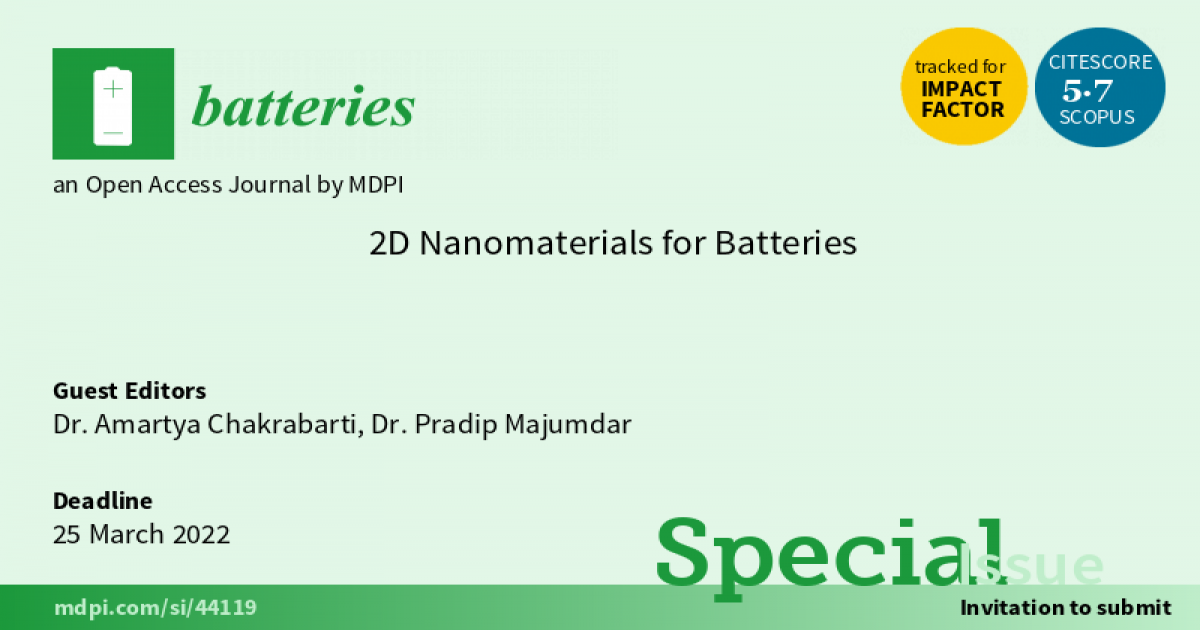2D Nanomaterials for Batteries
A special issue of Batteries (ISSN 2313-0105).
Deadline for manuscript submissions: closed (25 March 2022) | Viewed by 5479

Special Issue Editors
Interests: synthesis and characterization of graphene and hybrid graphene nanomaterials; synthesis of boron nitride nanomaterials; hydrothermal synthesis of transition metal dichalcogenides; polymer nanocomposites
Interests: Li-ion battery; fuel cell; nanostructured materials; multi-physics modeling
Special Issues, Collections and Topics in MDPI journals
Special Issue Information
Dear Colleagues,
Two-dimensional (2D) nanomaterials have emerged as a new class of promising materials with a wide variety of applications in diverse fields. While graphene is considered to be the most important member of this distinct class of materials, hexagonal boron nitride nanosheets (hBNNS), nanodimensional transition metal dichalcogenides (TMDCs), and many layered transition metal oxides are also included in the same family. The significantly high surface to volume ratio of such nanomaterials makes them suitable for manufacturing a variety of polymer nanocomposites and hybrid nanocomposites useful for battery applications.
In this Special Issue of Batteries, we invite manuscripts focused on 2D nanomaterials directed towards application in the battery sector, especially in the development of newer anode or cathode electrodes materials including, but not limited to, NMC batteries, NMC/graphite, NMC/Graphene, Li-MnO-Graphene, LTO/Graphene, lithium-metal oxide-graphene, and boron-doped semiconductors. Original research articles and reviews involving synthesis, characterization, fabrication, and applications are welcome.
Dr. Amartya Chakrabarti
Dr. Pradip Majumdar
Guest Editors
Manuscript Submission Information
Manuscripts should be submitted online at www.mdpi.com by registering and logging in to this website. Once you are registered, click here to go to the submission form. Manuscripts can be submitted until the deadline. All submissions that pass pre-check are peer-reviewed. Accepted papers will be published continuously in the journal (as soon as accepted) and will be listed together on the special issue website. Research articles, review articles as well as short communications are invited. For planned papers, a title and short abstract (about 250 words) can be sent to the Editorial Office for assessment.
Submitted manuscripts should not have been published previously, nor be under consideration for publication elsewhere (except conference proceedings papers). All manuscripts are thoroughly refereed through a single-blind peer-review process. A guide for authors and other relevant information for submission of manuscripts is available on the Instructions for Authors page. Batteries is an international peer-reviewed open access monthly journal published by MDPI.
Please visit the Instructions for Authors page before submitting a manuscript. The Article Processing Charge (APC) for publication in this open access journal is 2700 CHF (Swiss Francs). Submitted papers should be well formatted and use good English. Authors may use MDPI's English editing service prior to publication or during author revisions.
Keywords
- 2D Nanomaterials
- graphene
- hexagonal boron nitride (h-BN)
- transition metal dichalcogenides (TMDCs)
- polymer nanocomposites
- Li-ion or NMC batteries
- NMC/graphite
- NMC/graphene
- battery life cycles/degradation
- battery capacity
- electrochemical reactions
- electrical conductivity
- battery charge/discharge cycles
Benefits of Publishing in a Special Issue
- Ease of navigation: Grouping papers by topic helps scholars navigate broad scope journals more efficiently.
- Greater discoverability: Special Issues support the reach and impact of scientific research. Articles in Special Issues are more discoverable and cited more frequently.
- Expansion of research network: Special Issues facilitate connections among authors, fostering scientific collaborations.
- External promotion: Articles in Special Issues are often promoted through the journal's social media, increasing their visibility.
- Reprint: MDPI Books provides the opportunity to republish successful Special Issues in book format, both online and in print.
Further information on MDPI's Special Issue policies can be found here.






